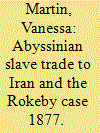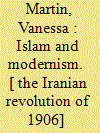|
|
|
Sort Order |
|
|
|
Items / Page
|
|
|
|
|
|
|
| Srl | Item |
| 1 |
ID:
183753


|
|
|
|
|
| Summary/Abstract |
In March 1877, the British searched a ship named The Rokeby and discovered eight Abyssinian child slaves on board. It is argued that, hitherto frustrated by the constant evasion of their attempts to supress the slave trade, they used the event to bring pressure on local government officials and merchants of Bushehr to cease their collusion and involvement. The result was a decline in the trade at least in the coast around Bushehr. There having been hitherto no specific studies of the Abyssinian slave trade to Iran, the case has also been taken as an opportunity to discuss it from its country of origin through Mecca and Jeddah, then in Ottoman territory, and to the Gulf ports of Iran, which allows an indicative comparison of Ottoman and Iranian policies of suppression. Rare insight has been provided into the experiences of the slaves themselves by the first-hand accounts of their journeys from Abyssinia given to the British.
|
|
|
|
|
|
|
|
|
|
|
|
|
|
|
|
| 2 |
ID:
183500


|
|
|
|
|
| Summary/Abstract |
There have been many interpretations of British policy in Iran between 1809 and 1914, but not infrequently a lack of precision as to what it was, with a certain tendency to believe that the British wished for greater control and influence over the country than they in fact did. This article seeks to demonstrate that Britain’s paramount concern was the defence of the route to India, and that, by contrast with the Russians, they refrained from involving themselves further until the increasing disorder from 1909 to 1914. The evidence for the argument is provided by the constantly expressed desire to curtail cost demonstrated by their attitude to expenditure. The article throws new light on the influential role of the government of India, which was required through out to bear a proportion of the cost, and which objected in the strongest terms to any further expenditure than was strictly necessary. Apart from the one deviation over the Tobacco Concession in 1890, the policy which Grey took over, rather than initiated, was military and strategic, aimed at a new enemy, Germany, rather than just Russia.
|
|
|
|
|
|
|
|
|
|
|
|
|
|
|
|
| 3 |
ID:
024150


|
|
|
|
|
| Publication |
London, I.B. Tauris & Co. Ltd., 1989.
|
| Description |
ix, 245p.hbk
|
| Standard Number |
1850431019
|
|
|
|
|
|
|
|
|
|
|
|
Copies: C:1/I:0,R:0,Q:0
Circulation
| Accession# | Call# | Current Location | Status | Policy | Location |
| 031497 | 955.05/MAR 031497 | Main | On Shelf | General | |
|
|
|
|
| 4 |
ID:
153588


|
|
|
|
|
| Summary/Abstract |
Islamist radicalism emerged in the Iranian Constitutional Revolution of 1906–9. This article examines the early stages of its emergence with particular reference to the provinces of Iran. It looks at the subject thematically and traces the development of an Islamist notion of the state, characterized by Islamic law, and the shaping of new views on nationalism, absolutism and the economy. Increasingly politicized ordinary people also influenced ideological change. The article begins by establishing the background and influence of individuals and groups who played a leading role in developing an Islamist radical political perspective and identity. It then discusses their vision for an alternative state in terms of the authority to govern, its institutions and its laws and considers their methods of organization and propagation to oppose the existing system, and their attempts to change it. Since the article is intended primarily for those interested in the history of Islamism, it ends by evaluating the stage it had reached in 1909.
|
|
|
|
|
|
|
|
|
|
|
|
|
|
|
|
| 5 |
ID:
105016


|
|
|
|
|
| Publication |
2011.
|
| Summary/Abstract |
This article looks at the Iranian Constitution of 1906 and its Supplement of 1907 in terms of the existing trend towards the centralization and strengthening of the state, looking in detail at the role of the reformist higher bureaucracy in pursuing these objectives in the drafting of the Constitution. It also considers the question of the long term trend relating to control of power in the form of the army, and the way the issue was handled in the two documents. It concludes that the rights of the people were weakened by these particular trends, and that modern principles of legitimacy recognized traditional practice with regard to the army, and thereby also undermined accountability.
|
|
|
|
|
|
|
|
|
|
|
|
|
|
|
|
|
|
|
|
|